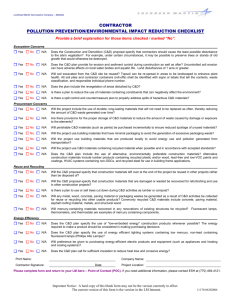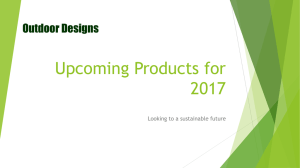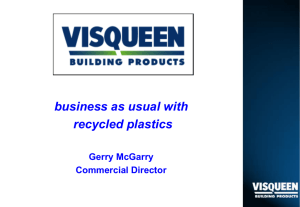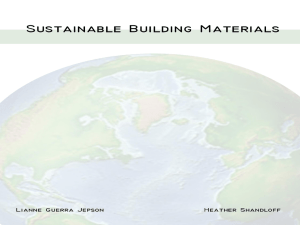Best Practice Guidance - Golf Environment Organization
advertisement
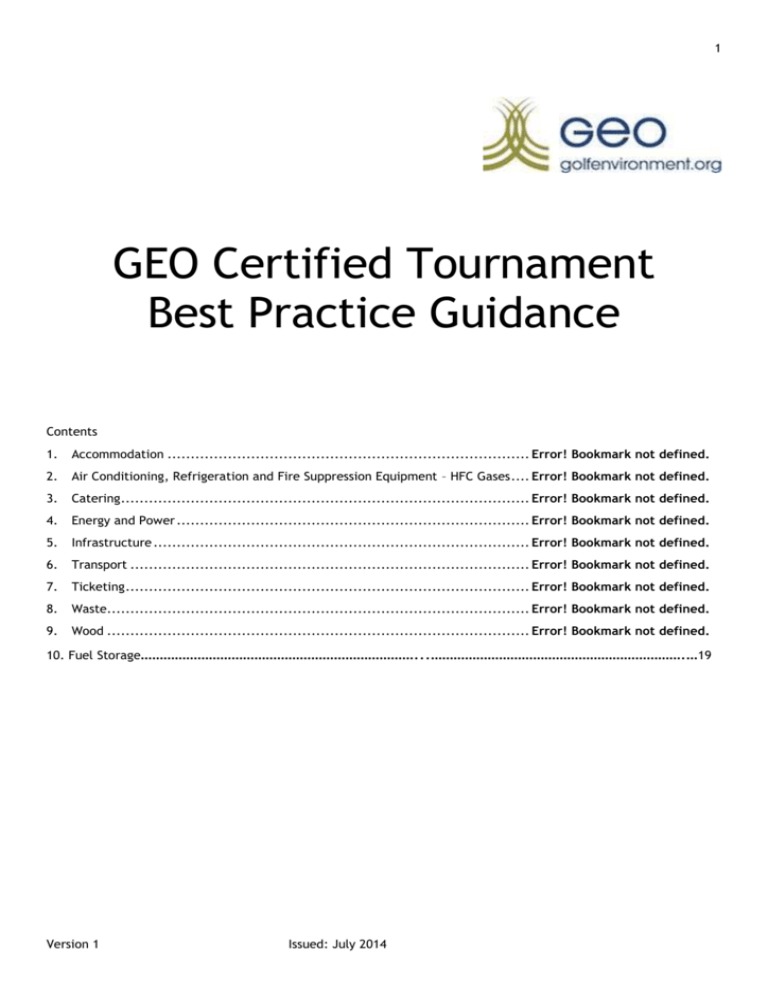
1 GEO Certified Tournament Best Practice Guidance Contents 1. Accommodation .............................................................................. Error! Bookmark not defined. 2. Air Conditioning, Refrigeration and Fire Suppression Equipment – HFC Gases .... Error! Bookmark not defined. 3. Catering ........................................................................................ Error! Bookmark not defined. 4. Energy and Power ............................................................................ Error! Bookmark not defined. 5. Infrastructure ................................................................................. Error! Bookmark not defined. 6. Transport ...................................................................................... Error! Bookmark not defined. 7. Ticketing ....................................................................................... Error! Bookmark not defined. 8. Waste........................................................................................... Error! Bookmark not defined. 9. Wood ........................................................................................... Error! Bookmark not defined. 10. Fuel Storage………………………………………………………………...………………………………………………………….…19 Version 1 Issued: July 2014 2 Waste Waste is an extremely important aspect of sustainability and must be managed in a way that limits damage to the environment and the requirement for new, raw material to be produced. It is essential that the waste hierarchy is followed at all times (see below) to reduce the amount of waste sent to landfill and increase the amount reused and recycled. It would, of course, be even better if waste was not produced in the first place and the simplest way to achieve this is to minimise packaging and unnecessary products. The Waste Hierarchy Prevent Reuse Recycle Recover Treat Dispose To achieve the requirements of the waste hierarchy, you should: Ensure recycling points are clearly labelled to enable the public to recycle their litter easily Have recycling points next to every waste bin so it is just as easy to recycle when possible, make sure these are emptied often enough so that they are never over spilling Front of house waste receptacles should be split into (as a minimum); dry recyclables, food and general waste. Back of house should be further split into glass, paper, cardboard, cooking oil, hazardous waste, medical waste, WEEE, metal, food, plastic and general waste. Following the tournament, other wastes such as wood and AstroTurf will be disposed of into skips on site and should be recycled/reused where possible. Encourage contractors to reuse their constructions/products at future events Minimise packaging and inform suppliers that this is a necessary aspect of their goods Minimise food wastage by careful planning Sub Section Company Best Practice Waste from event set up (from 2 months out) Contractors and Waste Contract Company Separate the following waste streams for collection and recycling: Front of House Waste Contract Company Public recycling provision Bin Suppliers Plastics – including any amounts of unavoidable plastic sheeting Waste wood – arising from tentage, grandstands and fitting out Wooden pallets should be stacked and collected for re-use or shredding to make wood chip Metal/Cabling Food waste Time the set up operations to avoid waste – e.g. late laying of carpets may eliminate the need for large amounts of plastic sheeting Clear signage and instruction on how to use each facility – training, induction and supervision, bins clearly labelled, and co-located to minimise contamination Awareness information to illustrate how waste will be separated and recycled – opportunity here for multi partner branding of responsible waste management Bins reused from other events and manufactured from recycled materials Version 1 Issued: July 2014 Action completed? 3 Back of House Catering and Hospitality Contract Catering Company Catering and hospitality recycling provision which covers: Food Plastics Glass Aluminium Cardboard Clear signage and instructions on each skip This will require careful planning of space for more, but perhaps smaller skips Local supply company and waste facility to minimise journeys Catering Waste Contract Catering Company Ensure all caterers adhere to policies, i.e. fast food outlets, hospitality, refreshment stands, with penalties for non-compliance Policy of no polystyrene and all packaging to be compostable Clearly signed bins back of house Policy on the sustainable sourcing, manufacture, consumption and disposal of food Contracts with local composting suppliers Ability to recycle cooking oil for fuel Use of local and ethical produce and food suppliers Back of House All trade stands at the event Pre, during and post event separation of cardboard, wood and plastics. Take Down Waste (for up to one week post event) Various contractors Material to be recycled or reused where possible Waste Removal Waste Contract Company Local recycling contract established prior to event Trade Waste Inform traders of the recycling schemes and penalties for noncompliance at the earliest opportunity. Clear segregation of waste streams (carpet, linings, wood, plastics, cabling, conduit, MDF) Ability to record total volume/weight of waste collected and volume/weight recycled or disposed Vehicles are most efficient in class and use low carbon fuels Version 1 Issued: July 2014 4 Version 1 Issued: July 2014 5 Energy and Power It is important that energy use is reduced at any golfing event. Power is often produced by non-renewable sources which is not sustainable and must be avoided where possible; other sources of power such as that obtained from renewable sources and more efficient machines and equipment will help to reduce the environmental damage. The overall aim for the use of energy and power is to minimise the environmental impact of energy and power supply and consumption during the event. Ways to reduce energy use: Use efficient equipment Turn equipment off when not in use Use LPG, recycled oil and other low carbon fuel Utilise technological advances and the newest systems Implement an energy reduction strategy Use renewable sources Sub Section Company Best Practice Temporary Power Units Power Supply Company (ies) Supply of low emission and low noise generator sets Use of LPG, recycled oils and/or other lower carbon fuels Power down policy when not required (e.g. at night) Local supply base to minimise transport Voltage optimisation system Provision of renewable energy systems (e.g. PVs, small wind turbines) Heating and air conditioning Supplier Best in class air conditioning units Careful location of units to maximise effectiveness Ensure best possible insulation and ventilation of marquees for efficient warming and cooling Refrigeration Supplier Liaison with tentage / catering providers to ensure units are positioned most efficiently Use of most efficient units. / latest technology No CFCs Lighting External Lighting System Supplier Low voltage, metal halide or high pressure sodium lighting systems Time/motion switch illumination across the site Time switches to contribute to evening / overnight power-down of site Ideally external lighting and car-park lighting will be linked to the main grid in preference to portable generator systems Internal Lighting Contractor Low voltage halogen or LED systems supplied in preference to incandescent bulbs Time-switches, PIR’s and main switches that are easy to access Tied in to evening / overnight power-down Version 1 Issued: July 2014 Action completed? 6 Media & TV TV Crews, Radio, Media & Large Screens Power supplied to all companies ideally from main grid Encourage all in media enclosure not to leave transformers and power packs plugged in unless in use Careful planning to identify aspects of media energy needs that can be tied into power-down Other technical voltage optimisation and efficiency measures Version 1 Issued: July 2014 7 Transport The efficient transport of spectators, players, goods and services is critical to the sustainability of an event. Transport, particularly air travel, is likely to have one of the highest environmental impacts. The overall aim for the event is to minimise the requirement for transport wherever possible and provide low carbon transport options where this is not possible. This will be achieved by: The use of efficient logistics and local supply base Provision of shuttle busses and public transport The supply of low carbon fuels and ultra-efficient vehicles The use of certified offset programmes for unavoidable aviation The use of equipment and vehicles that are considered to be the best in class with regard to environmental performance Recording environmental data such as fuel consumption to enable a post event audit (see below) Sub Section Spectator travel Company Rail Best Practice Optimise services provided by train company to maximise capacity Combined tickets and deals to incentivise rail use to maximum capacity Effective linking of trains and shuttle buses Website – including linking/promotion of rail times from key towns and cities Cars Incentive for car sharing Shuttle Buses Optimise location for park and ride, to reduce congestion and to maximise efficiency for car in and out times Maximise number of energy efficient and low carbon buses and coaches. In preference use hybrid, LPG, hydrogen or another low carbon energy option Buses stored overnight close to point of use Driver training and no idle policy Private Hire / Taxi / Executive Travel, Courtesy Cars Hybrid or low carbon cars or minibuses Spectator flights Use website to encourage spectators to voluntarily compensate for their flights to the event using an approved carbon payback scheme Journey planning software, GPS or journey sharing system Executive minibuses available and used in preference to multiple cars Provision of ‘efficient travel’ guidance Player air travel Version 1 Executive travel & Compensation commitment for journeys contracted to players and entourage, including US and European Team flights. Issued: July 2014 Action Completed? 8 transfer services Use of latest biofuel technology for team and entourage flights Executive travel & transfer services Utilise rail as far as possible and encourage car sharing for pre event planning trips Staff and supply deliveries to site Catering, hospitality and other bulk staff Well planned logistics covering meeting points, group collection, bus transportation etc. Other transport services Buggies, forklifts, on site utility vehicles, promotional vehicles. Use as many electric powered utility vehicles as possible Organiser travel Version 1 Raise staff awareness Interface with caterers, cleaning contractors, hospitality providers and others coordinating group staff to increase number of passengers per vehicle If electric – battery disposal and recycling policy If petrol/ diesel – use low carbon alternatives, including biodiesel Issued: July 2014 9 Accommodation Large events create a significant demand for accommodation; through choosing hotels, bed and breakfasts and selfcatering rentals wisely, the wider footprint of an event can be reduced and its social and environmental reputation can be improved. Individuals and companies should therefore be encouraged to consider the environmental credentials of their accommodation before booking. Actions Identify any local accommodation that has received sustainable certification such as the Green Tourism Award Ensure that the hotel/bed and breakfast still deserves its accreditation and is still working sustainably In order to encourage the use of sustainable accommodation, it is essential that information is made widely available; ideally via the event website and initial communications with spectators, suppliers and staff. Details should include what environmental awards have been gained and what has been done in order to achieve them. Giving people this information up front should encourage them to choose sustainable and green accommodation throughout their visit to the event If possible, agree a discounted daily rate or other incentive from the hotel for people attending the event Provide shuttle buses from the hotel to the event Provide transfers from the local train station to the hotel Catering It is essential that catering at events is sustainable, this includes the food, the packaging and the waste produced by both. 1. Food Food should be fresh to reduce wastage Version 1 Issued: July 2014 10 - Sourced locally where possible to decrease amount of travel required and help to improve the local economy and community Meat should be sourced from producers with high welfare standards Fruit and vegetables should be either organic or treated with minimal chemicals on farms with good environmental credentials Only sustainable fish should be used 2. Packaging Packaging should be kept to a minimum and suppliers to caterers should be briefed on this requirement and have a clear understanding. Where possible, packaging should also be made from recycled material and be recyclable or compostable; suppliers should avoid plastic as this is difficult to dispose of sustainably. 3. Waste Waste from food outlets can be minimised by using the following techniques: Use portion control to avoid food being left Carefully plan the menu and control stock accordingly Be aware of how many people are expected at the event on any day Handle perishable food in a way that prolongs its freshness Avoid disposable crockery and cutlery Compost any waste food where possible Unavoidable food and packaging waste should be separated onsite and collected by a registered waste carrier who will send food to a composting facility and separate packaging further for recycling. Sub Section Catering Company Drinks and Refreshments Best Practice Use of efficient drinks coolers and refrigeration equipment Recycled plastic cups Avoid all polystyrene Restaurant and Meal Providers Local providers Organic, seasonal, local produce Recyclable cutlery, crockery and napkins Mobile Vans / Stands Recyclable cutlery, crockery and napkins Clear signage to recycling bins Connection to site electrical supplies (Grid?) rather than portable generators where possible High efficiency chillers and refrigeration – non HFC or HCFC Commitment to enter into food waste disposal programme Use of FSC packaged sandwiches Minimise packaging Avoid polystyrene Version 1 Issued: July 2014 Action Completed? 11 Infrastructure Temporary events usually require a considerable amount of infrastructure to be installed at the chosen venue. The amount and type of infrastructure obviously depends on the size and requirements of the event and the facilities already in place at the venue. From a sustainability point of view, impacts from infrastructure tend to arise from: 1. The kind of materials the infrastructure is made from 2. 3. The careful selection of materials used for event infrastructure can make a big difference to sustainability. Temporary event infrastructure usually involves a lot of wood, plastic, and paint – all of which can have negative environmental impacts and human health impacts. More sustainable alternatives are easily obtainable however. Where the infrastructure has been manufactured and how far it has travelled If infrastructure is being manufactured on the other side of the world and then shipped great distances to be used at the venue, this will result in high carbon emissions as a result of the transport involved. It is therefore worth considering where the materials are made, or being hired in from and finding out if equivalent materials can be sourced more locally. What happens to it after the event The way the infrastructure is used post-event plays a major role in assessing the overall sustainability of the event. If infrastructure is only used once, this will represent a huge impact, as the waste generated will be very significant. Re-use is the best option, followed by recycling. Type of Infrastructure Tents, Pavilions and Marquees Best practice Materials Transport Design & Use Postevent Re-used and re-usable components – frames, outerskins and flooring High use of recycled materials, low VOC paint, natural fabrics etc. Use of recycled aggregates in ground preparations Efficiency of delivery and removal system – vehicle capacity, fuels Design and layout to minimise lighting, heating and cooling ventilation/insulation Low carbon assembly system (e.g. gas powered forklifts / electric buggies and utility vehicles) Waste minimisation, e.g. avoiding the use of plastic coverings where unnecessary (e.g. carpets) Full recycling/re-use policy for fittings, fixtures and materials –linings, carpets, pelmets etc. Thorough recycling policy and process for waste materials and takedown Local suppliers as far as possible Portacabins and toilets Transport Grandstands Materials Waterless urinal portaloos and/or recycled/rainwater units for flushing Recycled paper hand towels and toilet rolls Secure waste water treatment Integration of recycled materials – e.g. plastic for seating Transport Locally / regionally sourced where possible Design & Use Minimal lighting or time-switch illumination Low carbon assembly system (e.g. gas powered forklifts / electric buggies and utility vehicles) Best in class energy efficiency ratings Internal and external TV Screens Signs & Hoardings Version 1 Design and Use Materials Postevent Materials Clear pathway from previous use to onward re-use Signs and hoardings manufactured from recycled materials or made to be easily recyclable Issued: July 2014 12 Transport Timber decking, fencing and floor coverings Materials Postevent Design & Use Temporary roadways Bus terminals and hardstandings Media Tent Version 1 Materials All signage to use FSC certified wood Use of low VOC paints and printing materials Manufactured locally or efforts made to reduce transport Transport with low carbon vehicles where possible Seek to use recycled or FSC certified timber products Consider use of long life, (recycled plastic) boardwalk rather than carpet covered timber If using carpet, minimise the carpeted area, seek a biodegradable floor covering product, and/or one derived from recycled materials Encourage re-use of timber products at other events Electronic systems to be switched off when not required Lighting to be controlled with time-switch to contribute to evening / overnight power-down of site Seek local trackway or other temporary roadway supplier Materials Using and re-using on site materials Use of recycled aggregates Materials All paper or paper products to be from recycled sources and / or FSCcertified Design & Use Seek a paperless media tent and recycle printer cartridges Use of electronic scoring Electronic systems to be switched off when not required Lighting to be controlled with time-switch to contribute to evening /overnight power-down of site Issued: July 2014 13 Wood Wood is used for event staging in a number of ways e.g., temporary structures, decking, ramps and steps, cladding and wood chip in paths and walkways. Wood products as also widely used e.g., MDF, chipboard and paper. Wood has the potential to have a low environmental impact and be highly sustainable as long as its procurement is responsibly sourced and its disposal planned. From March 2013 there is a new EU regulation that requires timber suppliers to be able to show where it’s come from as well as that it is legal. As part of sustainable procurement the question as to where the wood is sourced from should be asked; suppliers should be able to demonstrate this. Responsible sourcing of wood There are a number of credible wood production certification programmes that are internationally recognized and the provision of wood from these sources should be included into any sustainable procurement code. FSC – Forest Stewardship Council FSC runs a global forest certification system with two key components: 1. Forest management 2. Chain of custody certification This system allows consumers to identify, purchase and use timber and forest products produced from well-managed forests. PEFC - Programme for the Endorsement of Forest Certification The Programme for the Endorsement of Forest Certification (PEFC) is an international non-profit, non-governmental organisation dedicated to promoting Sustainable Forest Management (SFM) through independent third-party endorsement. EU Timber Regulation (EUTR) Timber sourced in the EU must now conform to the EUTR which came into force on 3rd March 2013, making it illegal to place illegally harvested timber and timber products on the EU market. Responsible sourcing of wood products As with all products that are sustainably procured, the following questions should be asked: 1. 2. 3. 4. 5. Where does it come from? Who made it? What is it made from? What is it wrapped in? What will happen to it after the event? Wood products may be made from either virgin materials or processed materials. Where virgin materials are used, these should be from certifiable sources (see above). Ideally, however wood products where possible have a degree of recycled content. Paper As with other wood products, paper can be made from virgin material or recycled material. Recycled content diverts waste from landfill but does require processing and bleaching. Again, virgin material should be sourced from certified forests and paper is branded from FSC forests or equivalent. Paper with a recycled content has a lower environmental impact and this will depend on the manufacturing process. Reducing paper consumption through electric documents, no-print policies, double sided printing, etc., can also help to reduce the environmental impact of paper. Disposal options You can make simple yet effective changes to your site's operations to allow more wood and wood products to be recycled by: allowing time for waste management planning and provide staff with training avoid coatings on wood or wood products provide storage area to protect materials from accidental and weather damage separating wood and paper to avoid contamination with other wastes Potential end uses for reclaimed wood: Version 1 Issued: July 2014 14 chipboard, oriented strand board bedding products for animals play surfaces and pathways remanufactured products – e.g., fibre composites architectural components landscaping commercial products – e.g., logs, fuel chips liquid fuel (ethanol and methanol) biofuel for combined heat and power plant Version 1 Issued: July 2014 15 HFC Gases in Air Conditioning, Refrigeration and Fire Suppression Equipment HFC gases and substances are commonly used in air conditioning, refrigeration equipment and fire suppressants. There are alternative substances that are available and can be used. It is recommended that an environmental policy should be in place to reduce or eliminate the use of HFCs wherever possible. Actions 1) Improve building design or temporary structures to avoid the need for air conditioning 2) Use equipment with non HFC substances such as ammonia, dimethyl ether in foams, refrigeration and fireprotection systems 3) Use equipment with climate friendly HFCs such as HFC-1234ze or HFO-1234yf (GWP 4) – these substances stay in the atmosphere for months rather than years. 4) See the F-Gas inspection certificates 5) Justification forms where avoidance is not possible. Version 1 Issued: July 2014 16 Ticketing The traditional ticketing process involves printing tickets for an event and then posting them out to the customer. The environmental impacts of this fall into three main categories: The carbon footprint: Although an individual ticket weighs very little, the sheer number of tickets printed and then distributed means the carbon emissions figure can be high. Pollution from the printing process: caused by using oil based inks and chemicals which “fix” the printing Waste: Although tickets are usually made from paper or card, they are often not recyclable due to holograms and other features which are designed to prevent ticket fraud Alternatives Many events are moving away from tradition ticketing to an e-ticket, or an m-ticket solution or are doing away with any kind of “ticket” and are instead using chip technology (in wristbands for example) to allow customer to gain access to an event. e-tickets (electronic tickets): Tickets are emailed to customers, who then print them out at home. E-tickets cut out the distribution impacts from traditional ticketing and also many of the printing impacts. m-tickets (mobile tickets): Ticket are sent out electronically but do not need to be printed. Customers show their m-ticket on a mobile device (phone / tablet / computer). Version 1 Issued: July 2014 17 Fuel Storage 1) Avoid high risk locations: within 50 metres of a spring, well or borehole within 10 metres of a watercourse places where spilt oil could enter open drains, loose fitting manhole covers or soak into the ground where it could pollute groundwater places where a spill could run over hard ground to enter a watercourse or soak into the ground where it could pollute groundwater areas at risk from flooding 2) Use a storage tank that: • is made of a material that is suitable for the type of oil stored • is of sufficient strength and structural integrity to ensure that it won’t burst or leak in ordinary use • has a way of preventing drain down by gravity e.g. top off-take and / or isolating check valves has either integral bunding or an external bund Integral Bunding These tanks have an integral secondary containment capable of holding 110% if the volume of oil the inner tank is designed to hold. Any ancillary equipment will also be within the secondary layer. External Bunding Secondary containment must hold at least 110% of the volume of oil the tank is designed to contain, it must be impermeable to oil and water with no direct outlet. If there is more than one oil storage tank in the system, the secondary containment must be capable of storing 110% of the biggest tank’s capacity or 25% of the total capacity, whichever is the greater. Version 1 Issued: July 2014
